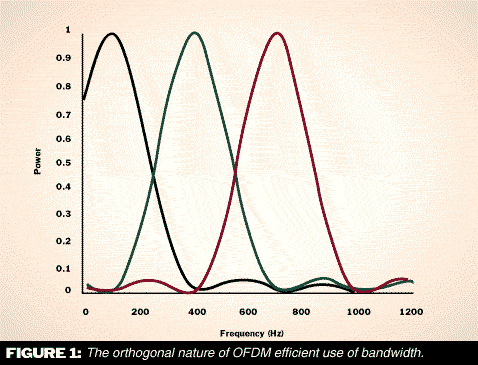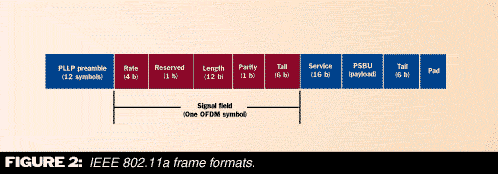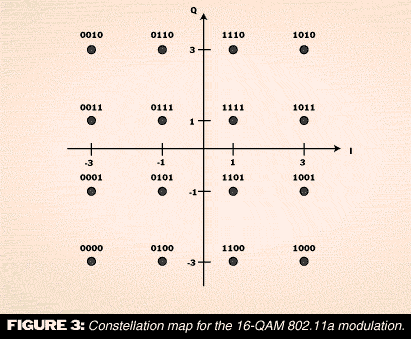Enabling Fast Wireless Networks with OFDM
Jim Geier
Source: CommsDesign D52 01, 2001, http://www.commsdesign.com/story/OEG20010122S0078
Spread-spectrum technology gives respectable data rates for many WLAN types, but for media-rich data, OFDM could provide a better solution.
Spread spectrum modulation has been the basis for many proprietary and IEEE 802.11-based wireless LANs (WLANs). Through the use of frequency hopping and direct sequence, these WLANs provide data rates from 1 to 11 Mbps. In addition, new activity within the IEEE 802.11 committee is considering a 22-Mbps version of direct sequence.
Regardless of these relatively high data rates, the demand for wireless broadband LANs and MANs, is pushing the envelope on spread spectrum technologies. Because of relatively inefficient use of bandwidth, spread spectrum systems will probably not satisfy the even higher data rates that multimedia applications require. In addition, multimedia applications operating outdoors or within industrial environments require a wireless network capable of operating more effectively in "RF hostile" areas.
For multimedia implementations, consider the more efficient and robust orthogonal frequency division multiplexing (OFDM). OFDM, sometimes referred to as multi-carrier or discrete multi-tone modulation, utilizes multiple subcarriers to transport information in from one particular user to another. An OFDM-based system divides a high-speed serial information signal into multiple lower-speed sub-signals that the system transmits simultaneously at different frequencies in parallel.
The benefits of OFDM are high spectral efficiency, resiliency to RF interference, and lower multi-path distortion. The orthogonal nature of OFDM allows subchannels to overlap, having a positive effect on spectral efficiency (see Figure 1). Each one of the subcarriers transporting information are just far enough apart from each other to theoretically avoid interference.
Figure 1. The orthogonal nature of OFDM efficient use of bandwidth.
This parallel-form of transmission over multiple subcarriers enables OFDM-based WLANs to operate at higher aggregate data rates, such as up to 54 Mbps with IEEE 802.11a-compliant implementations. In addition, interfering RF signals will only destroy the portion of the OFDM transmitted signal related to the frequency of the interfering signal.
OFDM exhibits lower multi-path distortion (delay spread), since the high-speed composite's sub-signals are sent at lower data rates. Because of the lower data rate transmissions, multi-path-based delays are not nearly as significant as they would be with a single-channel high-rate system. For example, a narrowband signal sent at a high rate over a single channel will likely experience greater negative effects from delay spread because the transmitted symbols are closer together.
In fact, the information content of a narrowband signal can be completely lost at the receiver if the multipath distortion causes the frequency response to have a null at the transmission frequency. The use of the multi-carrier OFDM significantly reduces this problem.
Multipath distortion can also cause inter-symbol interference, which occurs when one signal overlaps with an adjacent signal. OFDM signals typically have a time guard of 800 ns, however, which provides good performance on channels having delay spreads up to 250 ns. This is good enough for all but the harshest environments. Delay spread due to multi-path propagation is generally less than 50 ns in homes, 100 ns in offices, and 300 ns in industrial environments.
Applying OFDM
Many wired and wireless standards bodies have adopted OFDM for a variety of applications. For example, OFDM is the basis for the global standard for asymmetric digital subscriber line (ADSL) and for digital audio broadcasting (DAB) in the European market. In the wireless network space, OFDM is at the heart of IEEE 802.11a and HiperLAN/2, which implement OFDM in a similar way. The main difference in implementation is how they perform convolutional encoding.
The wireless network industry has been growing significantly over the past year. There are now many established and startup companies developing high-speed wireless network products to provide wireless multimedia applications. The higher data rates and robust communications of OFDM enable the implementation of WLANs and MANs supporting higher-speed applications operating over wider areas, where the environment is somewhat hostile toward radio transmissions.
An ideal application for OFDM is to satisfy needs for wireless point-to-point and point-to-multipoint configurations. In fact, most initial products based on OFDM are providing this capability. Many more wireless MAN products based on OFDM will begin appearing on the market in early 2001. A problem with implementing WLAN products based on OFDM, however, is the limited range they exhibit because of high operating frequency combined with relatively low power.
This makes it difficult to maintain acceptable signal-to-noise ratios (SNRs) over longer distances. As a result, a relatively large number of access points are needed to provide enough radio coverage for supporting mobility in local areas. With this in mind, suppliers of OFDM technology may wait until prices decrease due to economies of scale before releasing OFDM-based WLAN products.
OFDM with IEEE 802.11a
In June 1997, the IEEE finalized the initial standard for wireless LANs (WLANs), IEEE 802.11. This standard specifies a 2.4-GHz operating frequency with data rates of 1 and 2 Mbps using either direct sequence or frequency hopping spread spectrum (FHSS). The IEEE 802.11 working group has since published two supplements to this 802.11 standard: 802.11a (OFDM in the 5.8-GHz band), and 802.11b (direct sequence in the 2.4-GHz band).
Many companies have developed and released WLAN products based on the 802.11b standard. The IEEE 802.11 working group elected to use a version of OFDM proposed by NTT and Lucent. Some companies are expected to launch 802.11a-based products in early 2001.
The IEEE 802.11a standard specifies an OFDM physical layer (PHY) that splits an information signal across 52 separate subcarriers to provide transmission of data at a rate of 6, 9, 12, 18, 24, 36, 48, or 54 Mbps. The 6-, 12-, and 24-Mbps data rates are mandatory for all products. Four of the subcarriers are pilot subcarriers that the system uses as a reference to disregard frequency or phase shifts of the signal during transmission.
A pseudo binary sequence is sent through the pilot subchannels to prevent the generation of spectral lines. The remaining 48 subcarriers provide separate wireless pathways for sending the information in a parallel fashion. The resulting subcarrier frequency spacing is 0.3125 MHz (for a 20 MHz with 64 possible sub-carrier frequency slots).
The primary purpose of the OFDM PHY is to transmit media access control (MAC) protocol data units (MPDUs) as directed by the 802.11 MAC layer. The OFDM PHY is divided into two elements: the physical layer convergence protocol (PLCP) and the physical medium dependent (PMD) sublayers.
The MAC layer communicates with the PLCP via specific primitives through a PHY service access point. When the MAC layer instructs, the PLCP prepares MPDUs for transmission. The PLCP also delivers incoming frames from the wireless medium to the MAC layer. The PLCP sublayer minimizes the dependence of the MAC layer on the PMD sublayer by mapping MPDUs into a frame format suitable for transmission by the PMD.
Under the direction of the PLCP, the PMD provides actual transmission and reception of PHY entities between two stations through the wireless medium. To provide this service, the PMD interfaces directly with the air medium and provides modulation and demodulation of the frame transmissions. The PLCP and PMD communicate using service primitives to govern the transmission and reception functions.
802.11a frame formats and protocol
Figure 2 illustrates the frame format for an 802.11a frame. The PLCP preamble field is present for the receiver to acquire an incoming OFDM signal and synchronize the demodulator. The preamble consists of 12 symbols. Ten of the symbols are short for establishing automatic gain control (AGC) and the coarse frequency estimate of the carrier signal. The receiver uses the long symbols for fine-tuning. With this preamble, it takes 16 microseconds to train the receiver after first receiving the frame.
Figure 2. IEEE 802.11a frame formats
The signal field consists of 24 b, defining data rate and frame length. The 802.11a version of OFDM uses a combination of binary phase shift keying (BPSK), quadrature PSK (QPSK), and quadrature amplitude modulation (QAM), depending on the chosen data rate (see Table 1). The length field identifies the number of octets in the frame. The PLCP preamble and signal field is convolutionally encoded and sent at 6 Mbps using BPSK no matter what data rate the signal field indicates.
| Table 1: Modulation Techniques of IEEE 802.11a OFDM | |||||
| Data rate (Mbps) | Modulation | Coding Rate | Coded bits per subcarrier | Code bits per OFDM symbol | Data bits per OFDM symbol |
| 6 | BPSK | 1/2 | 1 | 48 | 24 |
| 9 | BPSK | 3/4 | 1 | 48 | 36 |
| 12 | QPSK | 1/2 | 2 | 6 | 48 |
| 18 | QPSK | 3/4 | 2 | 96 | 72 |
| 24 | 16-QAM | 1/2 | 4 | 192 | 96 |
| 36 | 16-QAM | 1/2 | 4 | 192 | 144 |
| 48 | 16-QAM | 3/4 | 4 | 288 | 192 |
| 54 | 64-QAM | 2/3 | 6 | 288 | 216 |
The convolutional encoding rate depends on the chosen data rate (see Figure 2 ). The parity field is one bit based on positive (even) parity, and the tail field consists of six bits (all zeros) appended to the symbol to bring the convolutional encoder to zero state.
The service field consists of 16 bits, with the first six bits as zeros to synchronize the descrambler in the receiver, and the remaining nine bits (all 0s) are reserved for future use (and set to zeros). The PLCP service data unit (PSDU) is the payload from the MAC layer being sent. The pad field contains at least six bits, but it is actually the number of bits that make the data field a multiple of the number of coded bits in an OFDM symbol (48, 96, 192, or 288). A data scrambler using a 127-b sequence generator scrambles all bits in the data field to randomize the bit patterns in order to avoid long streams of 1s and 0s.
With 802.11a OFDM modulation, the binary serial signal is divided into groups (symbols) of one, two, four, or six bits, depending on the data rate chosen, and converted into complex numbers representing applicable constellation points. If a data rate of 24 Mbps is chosen, for example, then the PLCP maps the data bits to a 16-QAM constellation (see Figure 3 ). The constellation is gray-coded.
Figure 3. Constellation map for the 16-QAM 802.11a modulation
After mapping, the PLCP normalizes the complex numbers to achieve the same average power for all mappings. The PLCP assigns each symbol, having a duration of 4 microseconds, to a particular subcarrier. An inverse Fast Fourier transform (FFT) combines the subcarriers before transmission.
As with other 802.11-based PHYs, the PLCP implements a clear channel assessment protocol by reporting a medium busy or clear to the MAC layer via a primitive through the service access point. The MAC layer uses this information to determine whether to issue instructions to actually transmit an MDSU.
Operating frequencies for the 802.11a OFDM layer fall into the following three 100-MHz unlicensed national information structure (U-NII) bands: 5.15 to 5.25 GHz, 5.25 to 5.35 GHz, and 5.725 to 5.825 GHz. As shown in Table 2, there are twelve 20-MHz channels, and each band has different output power limits. In the US, the Code of Federal Regulations, Title 47, Section 15.407, regulates these frequencies.
| Table 2: IEEE 802.11a OFDM Operating Bands and Channels | |||||
| Band | Channel numbers | Center frequency (MHz) | Maximum output power (with up to 6 dBi antenna gain) | ||
| U-NII lower band (5.15 to 5.25 MHz) |
36 40 44 48 |
5180 5200 5220 5240 |
40mW (2.5mW/MHz) | ||
| U-NII middle band (5.25 to 5.35 MHz) |
52 56 60 64 |
5260 5280 5300 5320 |
200mW (12.5mW/MHz) | ||
| U-NII upper band (5.725 to 5.825 MHz) |
149 153 157 161 |
5745 5765 5785 5805 |
800mW (50mW/MHz) | ||
The 802.11a standard requires receivers to have a minimum sensitivity ranging from -82 to -65 dBm, depending on the chosen data rate. Because of the relatively low power limits in the lower frequency bands, implementers should carefully consider range requirements of the application before choosing a particular band.
OFDM's high degree of spectral efficiency resiliency to interference and multipath distortion, and existing inclusions in the leading higher rate WLAN standards, provides a strong base for the development of newer broadband wireless networks. The technology is certainly proven; however, the unknown future unification of a single standard is causing some grief among those deciding which version of OFDM to implement in their products. In addition, the non-conformance to a single standard is hampering the benefits of economies of scale as companies utilize dissimilar components based on their chosen version of OFDM. Regardless, the future for OFDM is bright as it gains significant momentum in the industry.


